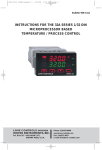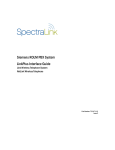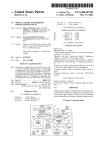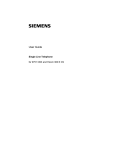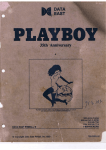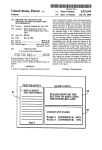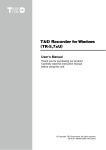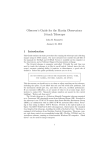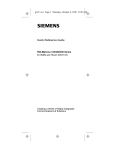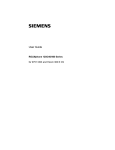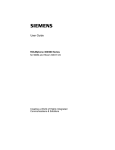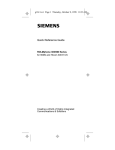Download liar cm SETUP
Transcript
United States Patent [191 [111 [45] Dang et al. [54] METHOD OF ENHANCING COMMUNICATION SETUP BETWEEN A COMMUNICATION STATION AND A TELECOMMUNICATIONS NETWORK 5,017,915 Patent Number: Date of Patent: May 21, 1991 OTHER PUBLICATIONS Data Communications User Manual for the CBX 8000, Release 8004 May 1985, pp. 28, 34, 52, 53. Data Communications User Guide for the Model 9751 [76] Inventors: Mieu-Hong Dang, 2100 Taylor Simonetti Ave., Austin, Tex. 78728; Jorge R. Taborga, 1802 Rainy Meadows Dr., Austin, Tex. 78758 [21] Appl. No.: 246,561 Sep. 19, 1988 [22] Filed: [51] Int. Cl.5 ............................................. .. CBX, May 1988, p. 30. Primary Examiner—Sandra L. O’Shea Assistant Examiner-Edwin C. Holloway, III Attorney, Agent, or Firm-Andrew J. Dillon [57] ABSTRACT A method is disclosed for enhancing communication H04Q 9/00 IMO/825.06; 340/825.16 [52] US. Cl. .............. .. [58] Field of Search .................... .. 340/825.06, 825.16; 370/79, 84, 99, 17; 375/8, 13, 121; 379/93, 94, 97, 98, 100, 216; 37l/49.1 setup between a communication station and a telecom munications network. An initial setup communication from the communication station is transmitted at a nor mal data rate and the response from the telecommunica tions network is utilized to selectively enable transmis sion at a higher data rate for subsequent communica References Cited tions. Additionally, requested communication parame U.S. PATENT DOCUMENTS ters are compared to previously utilized parameters which have been stored. Communication is established [56] 4,620,294 10/1986 Leling et al. ........................ .. 379/98 4,621,366 11/1986 Cain et al. .... . . . 4,680,781 7/1987 Amundson et al. . 4,688,170 8/1987 Waite et al. 4,733,303 3/1988 Koshiishi . . . . .. .... .. 379/93 .. . .. .. . . .. . . . 4,734,931 3/1988 Bourg et al. 4,756,007 7/1988 Qureshi et al. . . .. . . . . . .. 379/98 . . . . .. 370/84 . . . . .. 379/94 .... .. 370/84 4,780,883 10/1988 O'Connor et al. 4,864,557 9/1989 375/13 by setting only those parameters which do not match previously stored parameters. In a preferred embodi ment of the present invention, a selected data call num ber is stored at the telecommunications network and automatically invoked by the communication station in response to the establishment of communication. 375/121 Morton et al. ...................... .. 370/17 3 Claims, 4 Drawing Sheets mrom Ma£n>—@64 liar cm SETUP av REQUESTING A, 6s SERVICE mow THE cax i 807 CHANGE Tie ueuux CHARACTER SPACING TO 50 PER SECOW 827 DFE 015A” CHAKSE THE lPLlNN MESSAGE >YE>I CHARACTER SPACING PREP]; ‘ 4 TO 7 PER SECOND INDICATE THAT _REO££STED PMITY AS NUT BEEN SET Q OUTPUT NO CARRIER MESSAGE lNDlCATE THAT REQUESTED FARITY HAS NOT BEEN SET US. Patent CPU May 21, 1991 / VOICE IDATA CHANNELS [22 347I 267 CPU 5,017,915 Sheet 1 of 4 MEMORY ‘ ROM “224 DATA PORT 1 '32 CPU / l DISPLAY ~ RAM I PBX 420 (30 TELEPHONE L“) $49. 2 COMPUTER Z42 "38 US. Patent May 21, 1991 Sheet 2 of 4 5,017,915 PROCESS THE COMMAND AS USUAL START CALL SETUP A46 PROCESS I WAIT UNTIL A CBX MESSAGE ARRIVES A48 52? SEND" Y" TO cax (54 PROCESS THE MESSAGE INTERNALLY WAIT UNTIL CALL SET UP IS COMPLETE OUTPUT NO CARRIER MESSAGE '60 62 US. Patent May 21, 1991 Sheet 3 of 4 ATDT<PHONE NUMBER) 5,017,915 54 START CALL SETUP BY REQUESTING A, 66 SERVICE FROM THE CBX 807 CHANGE THE UPLINK CHARACTER SPACING >0 TO 50 PER SECOND BE EN SET Y? 7a "0 DFE DISABLE V74 INDICATE THAT M REQUESTED PARITY 827 CHANGE THE UPLINK MESSAGE 32- CHARACTER SPACING — PREFIX am ? NO HAS NOT BEEN sET Q). 1-13. 4/4} To 7 PER SECOND US. Patent May 21, 1991 Sheet 4 of 4 5,017,915 9% PROCESS THIS CBX MESSAGE SET LINE PARITY 11/90 OUTPUT N0 CARRIER MESSAGE INDICATE THAT I02 REQUESTED . PARITY HAS NOT BEEN SET fig.’ 1 5,017,915 METHOD OF ENHANCING COMMUNICATION SETUP BETWEEN A COMMUNICATION STATION AND A TELECOMMUNICATIONS NETWORK tween a communication station and a telecommunica tions network which permits higher data rate communi cation where acceptable to the telecommunications network. It is yet another object of the present invention to provide a method of enhancing communication setup BACKGROUND OF THE INVENTION 1. Technical Field This invention relates in general to methods for en hancing communication setup between a communica between a communication station and a telecommunica tion station and a telecommunications network, and in tion network by resetting only those communication parameters which vary from previously utilized param particular to methods for establishing communication at Y an increased data rate. Still more particularly, this in eters. vention relates to methods for establishing communica The foregoing objects are achieved as is now de scribed. An initial setup communication from the com munication station is transmitted at a normal data rate and the response from the telecommunications network is utilized to selectively enable transmission at a higher tion between a communication station and a telecom munications network by minimizing the number of communication parameters which must be set before communication is established. 2. Background Art It is well known in the prior art to utilize computer program controlled telephone switching systems to 2 between a communication station and telecommunica tions network. It is another object of the present invention to pro vide a method of enhancing communication setup be data rate for subsequent setup communications. Addi tionally, requested communication parameters are com pared to previously utilized parameters which have interconnect individual telephone stations, digital termi been stored. Communication is then established by set nals, personal computers and large main-frame comput ting only those parameters which do not match previ ers. Such intercommunications may be utilized to pro 25 ously stored parameters. In a preferred embodiment of ' vide voice and/or data communications. In a typical application, the telephone switching system is utilized 20 the present invention a selected data call number may be stored at the telecommunications network and auto matically invoked by the communication station in re to establish communication connections between two sponse to the establishment of communication. communication stations, both of which may include an associated computer facility connected to a communi 30 BRIEF DESCRIPTION OF THE DRAWINGS cations pair. Thereafter, the operator generally utilizes a modem which converts digital signals output by a The novel features believed characteristic of the in computer to analog signals suitable for transmission by the telephone system. Alternately, certain systems per mit direct communication by digital signals over special vention are set forth in the appended claims. The inven tion itself however, as well as a preferred mode of use, communication pairs. More recently, certain systems have been proposed which incorporate computer facilities which are di rectly connected to a communications pair. In such systems, the computer facility is utilized to emulate the functions of a telephone communication system. In this manner, the telephone communication station is no further objects and advantages thereof, will best be understood by reference to the following detailed de scription of an illustrative embodiment when read in conjunction with the accompanying drawings, wherein: FIG. 1 depicts a pictorial representation of a commu nication system which may be utilized in accordance with the method of the present invention; FIG. 2 depicts a high level block diagram of the communication system of FIG. 1; longer required for computer data call origination pur FIG. 3 depicts a logic ?ow chart illustrating the auto poses. 45 matic call technique of the method of the present inven In either of the two aforementioned systems, it is common during call setup for a multitude of command and information messages to be transmitted back and tion; and FIGS. 40 and 4b form a logic flow chart illustrating the enhanced data rate and stored communication pa forth between a computer facility and a second com rameter techniques of the method of the present inven puter facility, or a Private Branch Exchange (PBX). 50 tion. Such messages may be directed toward acknowledge ment of selected parity, data rate, and other call param DETAILED DESCRIPTION OF THE PREFERRED EMBODIMENT eters, as well as indications of the progress of the inter connection. With reference now to the ?gures, and in particular The process involved in this communication setup 55 with reference to FIG. 1, there is depicted a pictorial typically takes approximately twelve to fourteen sec representation of a communication system which may onds to complete. While this does not represent a sub be utilized in accordance with the method of the present stantial time period, systems which must establish many invention. As may be seen, the communication system such calls could save substantial time by reducing the includes a telephone 10 which preferably permits both amount of time required for each call setup. It should 60 voice and data communication. Telephone 10 may be therefore be apparent that a need exists for a method which can substantially reduce the amount of time re quired for call setup between a communication station and a telecommunications network. SUMMARY OF THE INVENTION It is therefore one object of the present invention to provide a method of enhancing communication setup implemented utilizing any telephone having a data/tele phony capability, such as the ROLMphone 244PC, manufactured by International Business Machines Cor poration. Telephone 10 is coupled, via a standard EIA 65 232D cable to a serial asynchronous port within com puter 12. Computer 12 within the depicted system is preferably provided by utilizing an IBM Personal Computer, an 3 5,017,915 IBM Personal System/2 or other similar system. As those skilled in this art will appreciate, computer 12 generally includes both a keyboard 14 and a video dis play device 16, which may be utilized to allow operator 4. cally invoke the Autocall capability when selected by the operator. If the Autocall %Y command is not present within the AT command line as determined by block 42, then input and to provide user discernible messages to an 5 block 44 illustrates the processing of the command in operator of the communication system depicted. In the system illustrated, telephone 10 may be utilized for data communicationin a manner very similar to that of a modem due to the fact that v the ROLMphone 244PC will support the AT command set which is uti lized in most modems. To permit such communication, telephone 10 is connected to a telecommunication sys tem such as a Private Branch Exchange (PBX) 20 which may be implemented utilizing the ROLM Com puterized Branch Exchange (CBX). This connection is the usual manner. Thereafter, the process terminates as depicted in block 62. However, if the Autocall %Y command is present within the AT command line, then block 46 depicts the beginning of the call setup process. Next, block 48 illustrates the process waiting until a message arrives from the Computerized Branch Ex change (CBX). Block 50 is then utilized to determine whether or not the message pre?x from the Computer ized Branch Exchange (CBX) is equal to “#97,” indi 15 cating that the Autocall function is available to the communication station and asking if the communication preferably made via a distributed wiring system which station desires to utilize the Autocall option. In this includes a plurality of telephone outlets 18. case, block 52 depicts the automatic transmission of a Referring now to FIG. 2, there is depicted a high “yes” signal to the Computerized Branch Exchange level block diagram of the communication system de picted in FIG. 1. As may be seen, telephone 10 prefera 20 (CBX) in response to the utilization of the Autocall %Y command. Next, block 54 illustrates the process waiting bly includes a Central Processing Unit (CPU) 26 as well until the call setup is complete before terminating the as both Read-Only-Memory (ROM) 28 and Random process as illustrated in block 62. Access-Memory (RAM) 30, which may be utilized in a If the message pre?x received from the Computer manner‘ well known in the art to store the control se quences utilized by Central Processing Unit 26 to oper 25 ized Branch Exchange (CBX) is equal to “#01,” indi cating that no data call number is stored within the ate telephone 10 in accordance with the method of the Computerized Branch Exchange (CBX), then block 60 present invention, Central Processing Unit 26 is prefera illustrates the output of a “NO CARRIER” message, bly implemented utilizing a Motorola 68000 processor. indicating that the call was not completed. In the event Of course, those skilled in this art will appreciate that 30 an unspeci?ed message has arrived from the Computer telephone 10 will also include circuitry which supports ized Branch Exchange (CBX) then block 58 illustrates a databus as well as the telephone and audio sections of the processing of that message internally. Thereafter, telephone 10. the process returns to block 48 to await the arrival of a As is typical of communication systems of this type, subsequent message from the Computerized Branch Private Branch Exchange 20 also includes a Central 35 Exchange (CBX). Processing Unit 22 which may be utilized to control the Referring now to FIGS. 4a and 4b, there is depicted activity of voice/data channels 24. Finally, computer 12 a logic flow chart which illustrates the enhanced data also includes a Central Processing Unit 32 which is rate and stored communication parameter techniques of coupled, in a manner well known in the computer art, to the method of the present invention. As above, the memory 34, data port 36 and display driver 38. Of 40 process begins with block 64 where a command is re course, memory 34 will generally consist of a combina ceived from the operator of computer 12. Again, such tion of Read-Only-Memory and Random-Access-Mem commands are coupled, via data port 36, to telephone ory as well as those types of memory typically sup 10 (see FIG. 2). In the event the command received is ported on magnetic media such as floppy disk. an ATDT command, indicating the desire of the opera With reference now to FIG. 3, there is depicted a 45 tor of the ROLMphone 244PC to place a data call, then logic flow chart illustrating the automatic call tech nique method of the present invention. As is illustrated, block 66 illustrates the beginning of the call setup pro cess by requesting service from the Computerized the method of the present invention begins at block 40 Branch Exchange (CBX). where a command is received from the operator of Next, block 68 is utilized to determine whether or not computer 12. Such commands are coupled, via data 50 a message has arrived from the Computerized Branch port 36, to telephone 10 (see FIG. 2). Central Process Exchange (CBX). If not, block 70 is utilized to illustrate ing Unit 26, within telephone 10, is programmed to respond to so-called “AT” modem commands and de termines, as depicted in block 42, whether or not the the determination of whether or not a call timeout has been reached. Those skilled in the art will appreciate that in many communications applications if a call has user has entered a “%Y” command within the AT com- 55 not been completed by the termination of a selected mand line. The %Y command is the command which is time period then the attempt at communication is termi utilized, in conjunction with the method of the present nated. If call timeout has not been reached, the process invention, to signify the desire of the operator to auto returns to block 68 to await a message from the Com matically invoke the automatic call or “Autocall” capa puterized Branch Exchange (CBX). bility of the method of the present invention. In the event that call timeout has occurred without a Autocall is a technique known in the art whereby a connection being made, then block 72 illustrates a deter selected data call number may be stored within a Pri mination of whether or not parity for the requested vate Branch Exchange (PBX) and made available to the communication has been set. In accordance with an operator of a communication station as an option which important aspect of the present invention, the desired may be manually selected during call setup. In contrast, 65 parity for a communications setup may not be set if the to this known technique, the method of the present requested parity is identical to the previous parity uti invention utilizes the %Y command in a manner which lized by the system. If parity has been set, as determined will be explained in greater detail herein to automati by block 72, then the process returns to block 66 to 5 5,017,915 attempt a call the second time. If parity has not been set, then block 74 is utilized to indicate that fact and the 6 In the event the call setup is complete, block 94 is utilized to determine whether or not the call was suc (CBX), block 76 is utilized to determine whether or not cessfully connected. If so, the process terminates as illustrated at block 102. If the call did not in fact con nect, then block 96 illustrates the determination of whether or not the requested parity parameter was set. If not, block 100 is utilized to provide an indication that the pre?x of the message is equal to “#13.” This com mand is utilized, in accordance with the method of the cess returns to block 66 to restart the call. If the re process returns to block 66 to attempt to establish com munication a second time. Returning again to block 68, after a message is re ceived from the Computerized Branch Exchange the requested parity parameter was not set and the pro present invention, to indicate a telecommunications 10 quested parity parameter was set, then the process passes to block 98 which illustrates the outputting of a network which will support a higher pacing rate during “NO CARRIER” message indicating the data call was call setup. That is, a higher data rate of communications not completed. Thereafter, the process terminates as between the communication station and the telecommu illustrated in block 102. nications network. _In the event the message pre?x is equal to #13, then block 80 illustrates the changing of 15 Those skilled in this art will appreciate that by utiliz ing the methods of the present invention a substantial savings in the time required to establish a data call be tween a communication station and Computerized which is generally utilized. Branch Exchange (CBX), or telecommunications net Block 78 is utilized to determine whether or not the message pre?x from the Computerized Branch Ex 20 work may be obtained. By enhancing the data rate at the uplink character pacing to ?fty characters per sec ond from the nominal seven characters per second which call setup communication takes place when the telecommunications network will accept higher data change (CBX) is equal to #14, indicating that the uplink character spacing should revert to seven characters per rates, the actual process of communication will be sub second. Next, block 84 is utilized to illustrate the deter stantially speeded up. Similarly, the utilization of previ mination of whether or not the Computerized Branch 25 ously stored parity parameters will generate a substan Exchange (CBX) message is a service message, that is, a tial time savings in communication establishment where “Call, Display, or Modify?” message. If not, the mes the communication parameters have not been altered. sage is processed, as illustrated in block 88. While the invention has been particularly shown and If the message detected at block 84 is a service mes described with reference to a preferred embodiment, it sage, then block 86 is utilized to depict a determination will be understood by those skilled in the art that vari of whether or not the requested parity has been previ ous changes in form and detail may be made therein ously set. If the requested parity is equal to the previ ously utilized parity, block 88 illustrates the processing of this message without resetting the parity value. If the without departing from the spirit and scope of the in vention. We claim: requested parity is not equal to previously utilized par 35 1. A method of enhancing communication setup be ity, block 90 illustrates the setting of line parity in accor tween a communication station and a telecommunica dance with the requested parameters. tions network, said method comprising the steps of: This important feature of the method of the present storing a selected communications parameter from a invention permits a substantial time savings in call setup previous communication; between a communication station and a telecommunica comparing said stored selected communication pa tions network by storing the previously utilized parity rameter with requested communication parameters value and comparing the requested parity with this for a current communication attempt; and previously utilized value. In the event the parity values establishing communication between said communi are equal, the system assumes that the parity value need not be changed and the communication station automat 45 ically attempts to establish communication with the previously utilized parity parameter. Of course, in the cation station and said telecommunications net work by setting only those communication parame ters not identical to said stored selected communi event the communications parameters have been altered cation parameter. 2. A method of enhancing communication setup be since the previous attempt at communication, the dura tion of time required to establish communication will tions network according to claim 1 wherein said se tween a communication station and a telecommunica approximately double; however, the substantial time lected communication parameter comprises a parity setting. savings realized on those occasions when parity param eters have not varied will compensate for this occa sional problem. After processing the service message received from the Computerized Branch Exchange (CBX), block 92 3. A method of enhancing communication setup be tween a communication station and telecommunications 55 illustrates the determination of whether or not the call setup has been completed. If not, the process returns to block 68 to await the arrival of a subsequent Computer network according to claim 1 further including the step of establishing communication between said communi cation station and said telecommunications network by setting said requested communication parameters in response to a failure to establish communication. ized Branch Exchange (CBX) message. # 65 i i t t








![mm [mm [1 um um [11115151116 |])|]1]](http://vs1.manualzilla.com/store/data/005839409_1-1dd2adaaab9a040f039445848c9c3135-150x150.png)
